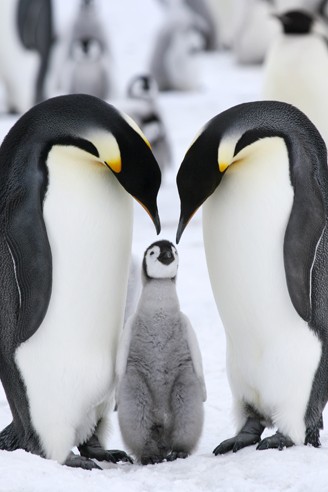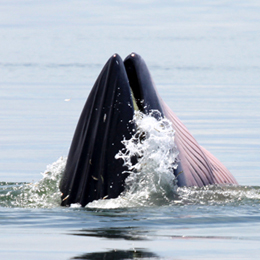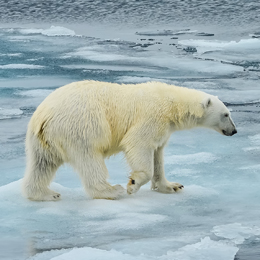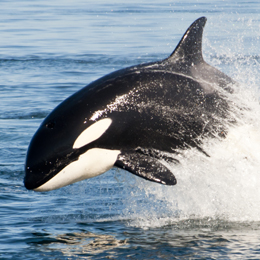Emperor Penguin
Of all the penguins found in the world, the Emperor Penguin is the largest and tallest with an adult penguin reaching up to a height of 122 cm and weighing as heavy as 45 kg. Besides the size and weight, the behavior of this penguin is also very peculiarly.

Emperor Penguin chicks in a blizzard
?
Image credits: Volt Collection/Shutterstock
Unlike other penguins, the Emperor Penguin doesn’t breed during the summer but lay their eggs and incubate them during the winter season, which is extremely cold around the Antarctic region.
This bird species belongs to the genus Aptenodytes which was first coined by an English zoologist in 1844. He created the word by combining word elements of Ancient Greek that roughly translates into ‘without-wings-diver’.
The specific name, however, has been honored after Johann Reinhold Forster, a German naturalist who went on a voyage with Captain James Cook in 1773 and is supposed to be the first person to have spotted the A. forsteri species.
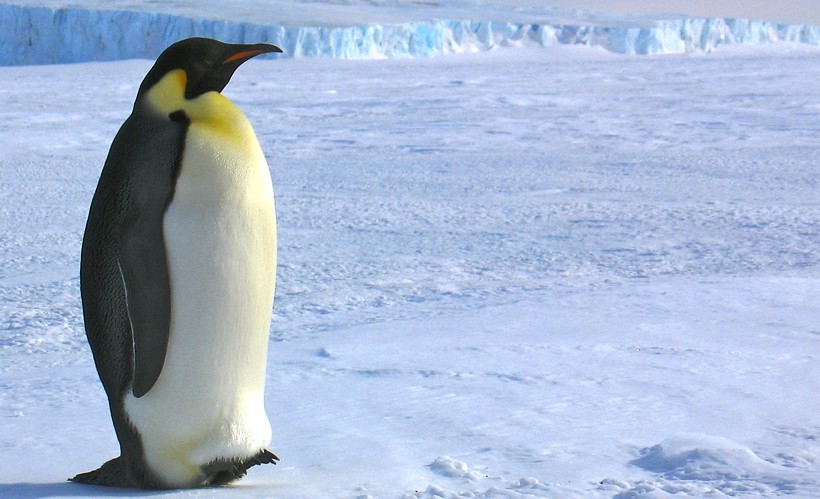
Emperor Penguin adult
?
Image credits: Stanislav Fosenbauer/Shutterstock
Characteristically, the Emperor penguins have small and stiff wings that render them flightless but help them swim and dive swiftly through the water. Both male and female penguins are similar in plumage and height which can measure up to 1.1m. However, the male emperor penguin has been found to weigh more than his counterpart. Since these birds incubate their eggs and raise the hatchlings in winter, both sexes lose a good amount of weight. But it is the male that sheds more weight since it is his primary role to incubate and protect the egg during the coldest period of the year.
Their average lifespan is 20 years but a few of them who were kept in captivity in the zoo have lived up to 50 years. The head and back of this bird is bluish black which lies in sharp contrast to its snow-white belly. Emperor penguins have a pale yellow breast along with bright-yellow patches around the ears. Their body is streamlined and their wings are flattened in the shape of flippers which helps them cope with their marine habitat. They have a remarkable ability to remain submerged under icy cold water up to almost 18 minutes while they dive as deep as 535 m (1755 ft). This extreme ability is possible because of their unusually structured hemoglobin that allows the bird to function normally even at very low oxygen levels. Also, this bird has a special feature to reduce metabolism when necessary and shut down the functions of non-essential organs.
Classification
Emperor Penguins have no subspecies. However, out of the 17 known species of penguins, the King Penguin is the only species that belongs to the same genus as the Emperor penguin, making it the closest relative. Compared to emperor penguins, king penguins are smaller with a height that varies from 70 cm to 100 cm and a weight ranging from 11 to 16 kg. As a result, they are ranked as the second largest penguin species that inhabits the Sub-Antarctic islands in the north of Antarctica. Similar to the emperor penguins, the king penguin’s diet also involves fish, squid and krills.
Anatomy and Characteristics
Like all species of penguins, Emperor Penguins have streamlined bodies for minimizing the drag while swimming. Their stiff flattened wings have also a flipper-like look. The tongue has rear-facing barbs that hinder the prey’s escape when caught in the mouth. Both males and females have similar size and coloration.
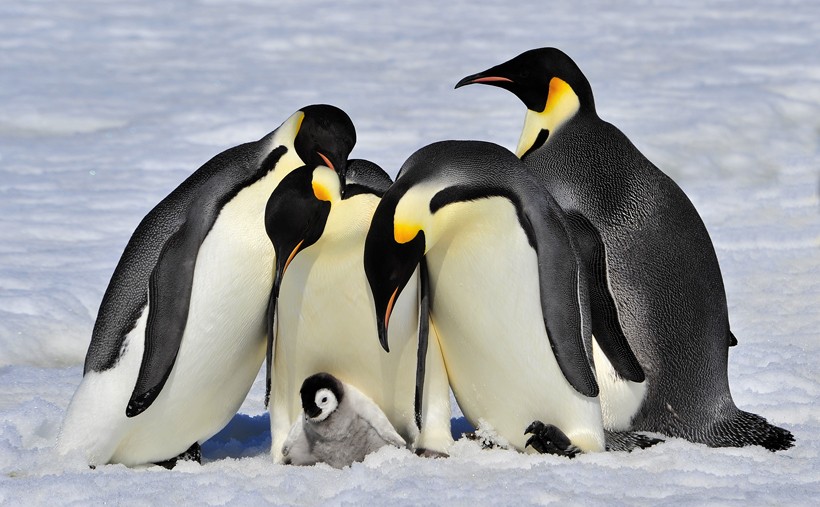
Emperor Penguin adults with chick
?
Image credits: vladsilver/Shutterstock
An adult penguin of this species has black dorsal feathers with a bluish tinge that covers the entire back, head, chin, throat, tail and the rear part of the flippers. The belly and inner side of the wings are white but change into pale yellow around the upper breast with the ears patched with bright yellow color. This peculiar black and white color of the penguin serves as a perfect camouflage while swimming and hunting for prey in the ocean.
The feet are colored black and clawed and webbed which supports swimming but doesn’t provide much help while walking on land. This is why they mostly move on land by sliding on their bellies and using their feet and flippers as propellers to move forward. The long bill of 8 cm is black at the upper mandible and pink at the lower mandible. Some penguins may also showcase orange or lilac colored lower mandibles. However, starting November, the dark plumage of the Emperor Penguins fades to brown and remains that way until February when the yearly molt starts.
Compared to other birds, the molting of Emperor Penguins is remarkably rapid, taking only an average of 34 days to complete. Moreover, the average life expectancy of Emperor Penguins is 20 years with a yearly survival rate being 95 %. But, in contrast to this impressive statistics, only 19 % of the chicks are able to survive the first year of their life.
Habitat
The Emperor Penguins' distribution encircles the South Pole, inhabiting the compact ice along the coast of the Antarctic continent. The breeding colonies are located offshore on stable pack ice where the ice cliffs combined with icebergs provides shelter against the extreme Antarctic wind.
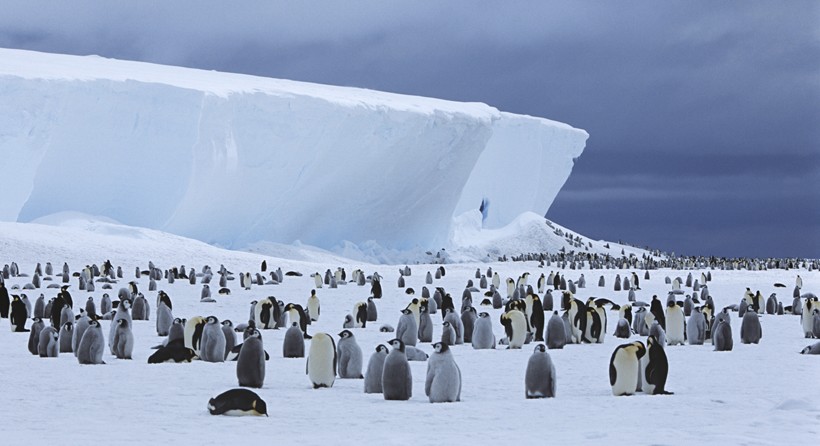
Emperor Penguin colony at iceberg
?
Image credits: bikeriderlondon/Shutterstock
These penguins usually hunt and feed themselves in the open sea and come onto land for the purpose of breeding. They have been found to travel as far as 200 kilometers across the Antarctic ice in order to reach a particular breeding colony. Unlike many other species of penguins that often migrates north during the winter, Emperor Penguins remains the entire year in the deep Southern ocean and doesn’t migrate anywhere. In fact, out of the forty identified breeding colonies of Emperor Penguins over compacted ice, only two of them are unattached with the Antarctic mainland.
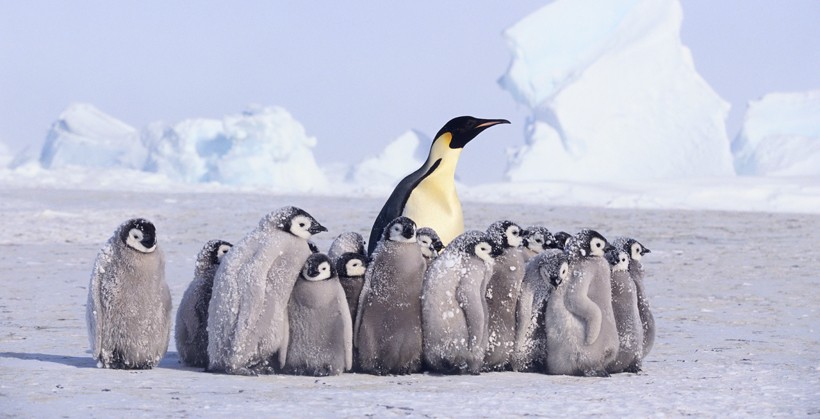
Young Emperor Penguins clustered around adult
?
Image credits: Volt Collection/Shutterstock
The habitat of these marine birds is concentrated in the Antarctic region which is considered as the coldest place on Earth. Extreme weather such as snowstorms, strong winds and freezing temperature occur every day in this region. However, the Emperor Penguins have evolved and adapted efficiently to this hostile environment with a few evolutionary physiological features.
The bodies of these flightless birds are covered with four layers of scaly feathers that not only protect them from the icy Antarctic winds but also serve as a waterproof coat. Their body also has the ability to store a lot of fats which provides them with long-lasting energy and insulates their body as well. Their small bills and stiff flippers help in conserving heat and the special nasal chambers minimize the heat that is normally emitted during each exhalation. Besides this, the veins and arteries are situated closely which provides them with the unique ability to recycle their own body heat, helping them to face the extremely cold habitat of the icy Antarctica.
Diet
The diet of Emperor Penguins involves mainly fish, cephalopods and crustaceans. As fish is the most important food source, the Antarctic silverfish covers the major portion of the penguin’s diet. Besides the Antarctic silverfish, these Antarctic birds prey also on marine animals like the glacial squid, the hooked squid and Antarctic krills.
Hunting
The Emperor Penguins hunt its prey in the surrounding open water of the Antarctic region. Their streamlined body helps them in moving swiftly through the water with great agility and speed. Their strong flippers combined with their aerodynamic body make them excellent swimmers with a swimming speed of 3.4 meter per second.
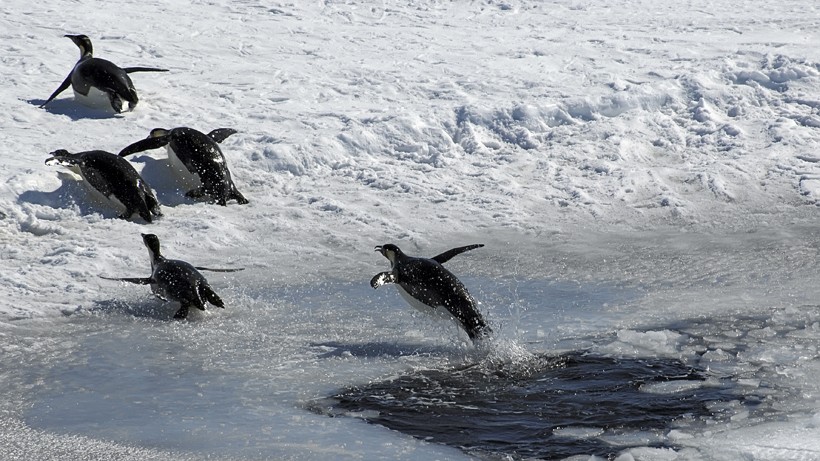
Emperor Penguin jumping out of an ice hole
?
Image credits: Armin Rose/Shutterstock
Among all aquatic birds that feed on marine animals, the Emperor Penguin is the only species that can dive up to 565 meters deep in the ocean and also stay submerged for as long as 18 minutes. This amazing swimming and diving capacity make them perfect hunters of their primary prey that mostly involves fish, squids and krills. Additionally, the coarse and spiky tongue of the Emperor Penguin prevents the slippery fish from escaping from their mouths when caught.
Predation
Larger marine carnivores of Antarctica often preys on this flightless bird. The type of predators varies depending upon geographic location. The Southern Giant Petrel, Leopard Seal and Killer Whales are some of the most common predators of the Emperor Penguin. However, among these predators, the Southern Giant Petrel is the most frequent hunter of these Antarctic birds. In fact, 30 % of the overall killings of Emperor Penguins are caused by the Southern Giant petrel. Especially the young Emperor Penguins that have still to optimize their amazing swimming and diving abilities often fall prey to Killer Whales and Leopard Seals.
Reproduction and life cycle
The Emperor Penguin is capable of breeding every year and they particularly choose the winter months for breeding which are not only the coldest and darkest months of the year but also the most hostile. They attain their sexual maturity by the age of three but commence breeding after one or three years. As their yearly reproductive cycle starts with the beginning of Antarctic winter in March and April, the adult Emperor Penguins travel to their colonial nesting area that is often situated 50 – 120 km (31 – 75 miles) from the edge of the ocean. Once in the nesting area, the male penguin tries to attract the female by making an ecstatic display that involves giving a courtship call by standing still and placing the head on the chest.
After they find their mate they move around the colony as a couple where the female is seen following the male. Emperor Penguins are considered as serially monogamous because they mate with only one partner each year.
The female lays one egg between in the month May or June and transfers the egg almost immediately to the male penguin. The warm brood pouch of the male is used to keep the egg warm which is placed nicely at the feet of the father penguin. As the male penguin starts to incubate the egg, the female Emperor Penguin leaves to forage for food in the open ocean.
The egg hatches after about 70 days during springtime, just when the female returns to feed her young and provide it with warmth by using the abdominal brood pouch.
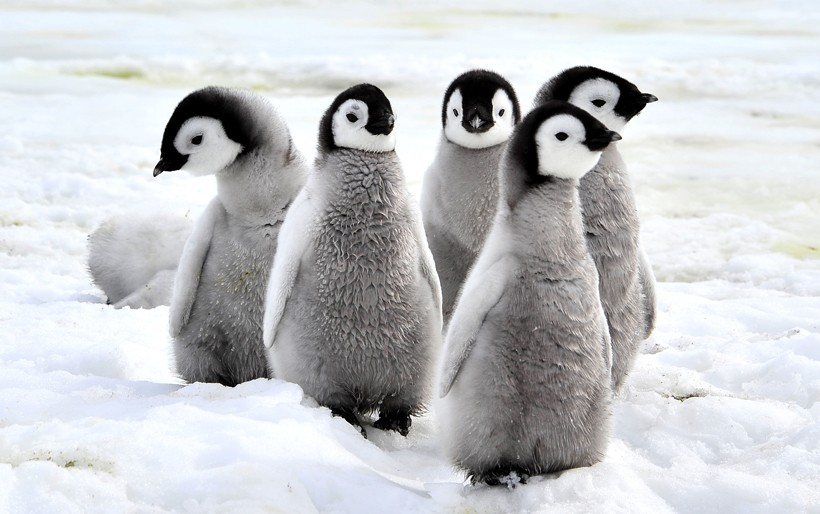
Chicks on the snow, Antarctica
?
Image credits: vladsilver/Shutterstock
After the egg hatches, the male penguin hands it over to the female and heads off to the open sea to feed itself. By that time, the male has lost a major portion of its weight as a result of spending the entire period of incubation without eating. After the refill, the father returns to help take care of the chick together with the mother. The chicks grow rapidly and develop their adult feathers by the month of December when the ice starts to melt, bringing the breeding ground closer to the ocean. Both male and the female take turns in looking after their young as the other goes out for hunting.
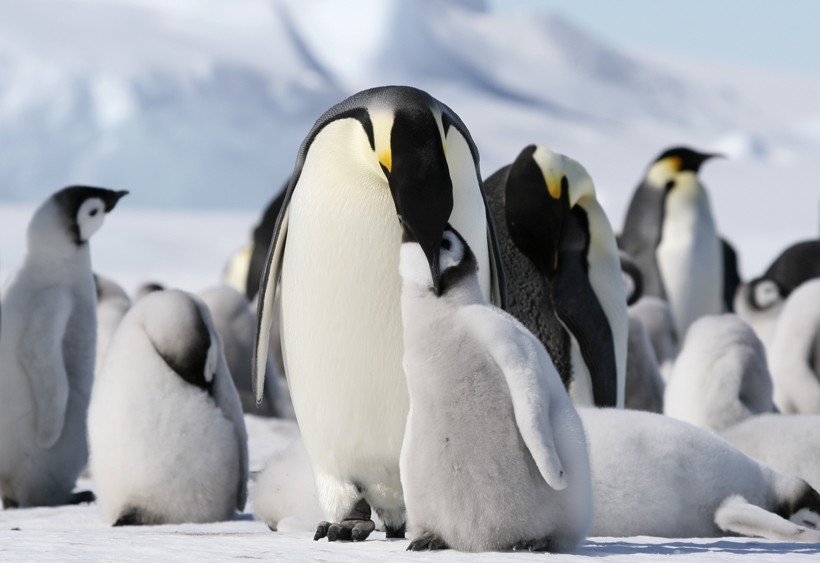
Emperor Penguin feeding chick with fishy paste
?
Image credits: TravelMediaProductions/Shutterstock
They feed their young one with a regurgitated fishy paste that they produce from their stomachs until the chick becomes big and strong enough to hunt on its own. This can take a maximum of six months.
Behavior, Communication and Intelligence
Emperor Penguins are social birds that form colonies containing thousands of penguins. They hunt together with members of their colony and may also coordinate their diving as well as surfacing. They are diurnal by nature and may remain active both during day and night, depending on the season. Emperor Penguins use vocal calls for communication with their mates as the calls of each penguin is distinct.
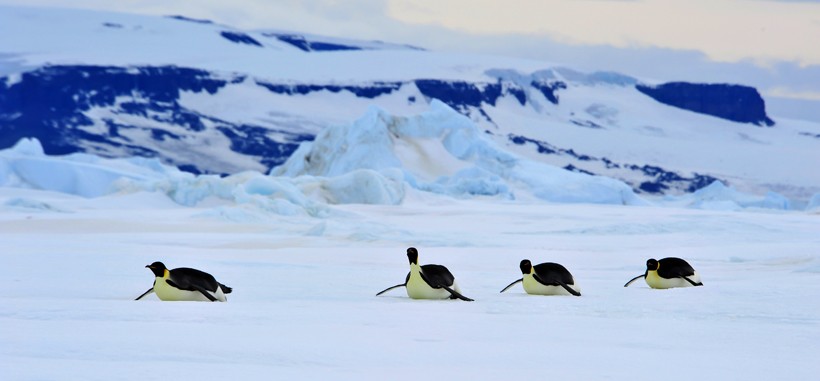
Emperor Penguins sliding over the snow
?
Image credits: vladsilver/Shutterstock
As they live in the harsh climate of Antarctica where the temperature can drop as low as -60 Celcius (-76 ͦ F), the Emperor Penguins are often seen forming a compact huddle in order to defend themselves from the extreme cold and conserve their body heat. The compact huddle or the turtle formation can contain as many as ten or several hundred penguins with each individual bird leaning forward on the neighbor.
Population and Conservation
The species of Emperor Penguin is concentrated largely around the Antarctic region with their entire population estimated to be around two hundred thousand breeding pairs. As per the list of the IUCN, this species of penguin has been categorized as the Least Concern.
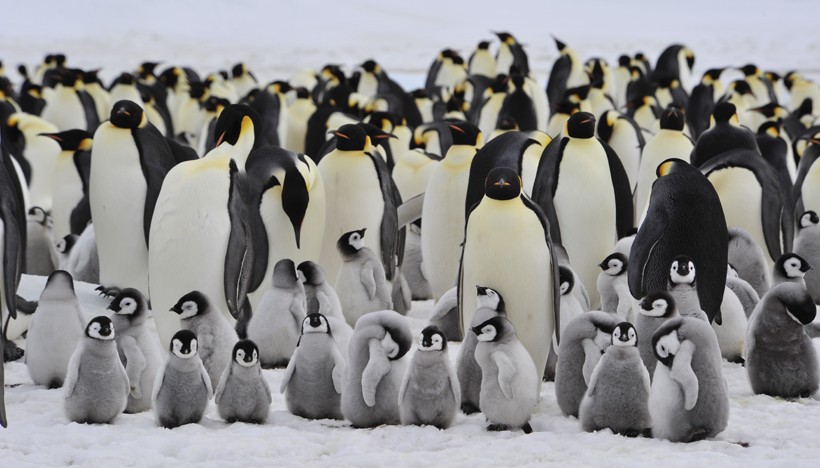
Emperor Penguin colony
?
Image credits: vladsilver/Shutterstock
Considering their current population and their adapting capacity, they are not likely to get extinct rapidly in the near future. However, even though their current population is healthy and stable, their habitat is increasingly getting affected by the meltdown of polar icecaps instigated by global warming and increased human activity around the Antarctic region.
Cultural Depiction
The unique lifecycle in the harsh environment of Antarctica combined with their distinctive feature that almost resembles the formal attire of tuxedo, Emperor Penguins have been a subject of fascination since the moment they were spotted.
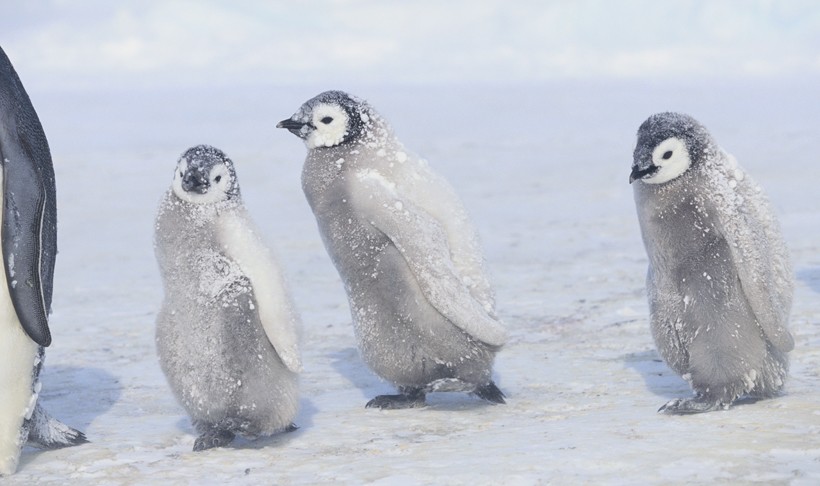
Young Emperor Penguins covered in snow
?
Image credits: Volt Collection/Shutterstock
The ‘March of the Penguins’ is a popular documentary of penguins which depicts the reproductive cycle of the Emperor Penguin. Besides the documentary, this amazing creature of the frozen world has also been depicted largely in many animated movies like the Happy Feet, Surf Up and also in the movie Madagascar.
Evolution
The genus Aptenodytes has two extant species that includes Emperor and King Penguins. According to the fossil records of the Ridgens Penguin (A. ridgeni) found in New Zealand that dates back to three million years in the late Pliocene epoch, there have been a third species of this genus which might have roamed the earth a few million years ago. However, further studies have suggested that the genus Aptenodytes might have split off from a particular branch that has produced all other species of penguins currently living on Earth.
Funfacts
- Of all the species of penguins found around the world, the Emperor Penguins are the largest, growing up to be more than 100 cm tall.
- Emperor Penguins don’t migrate and spend their entire lives in the Antarctic, the southernmost continent of Earth where it can get cold as -60 ͦC.
- Emperor Penguins have special physical features that allow them to keep on recycling their very own body heat.
- They are the only species that can live their entire life without ever setting foot on land.
- It is the male Emperor Penguin that incubates the egg continuously for two months without eating and bearing the harshest weather.
- Emperor Penguins are serially monogamous.
